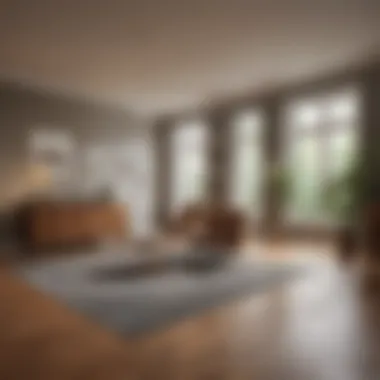Calculating Square Footage: A Practical Guide


Intro
Calculating square footage is a fundamental skill in various fields, especially in real estate and interior design. Whether you are buying a new home, renovating an existing space, or designing a room, knowing the accurate size of your area is crucial. This article intends to provide detailed methodology on how to measure room sizes effectively. Readers will explore various techniques that cater to different room shapes. Furthermore, the article will outline necessary tools for precise measurements and discuss the significance of square footage in practical scenarios. Common measuring mistakes will also be highlighted, with suggested solutions to enhance reliability in your calculations.
Home Design Inspiration
Understanding the square footage of a room leads to well-informed design decisions. It helps in visualizing how to utilize space more effectively. Below are some inspirations that contemplate the interrelation between room size and design.
Architectural Styles
Many unique architectural styles emphasize spatial utilization. For example, open-concept plans create a seamless flow between spaces. In contrast, traditional layouts may opt for partitioned rooms. Understanding these styles can inform the decision-making process about design and layout as it relates to room dimensions. Knowing exact square footage allows architects and designers to make better choices tailored to their client's needs.
Innovative Decor Trends
Current trends focus on maximizing space through clever decor choices. Minimalist designs emphasize functionality and clean lines, while multi-purpose furniture becomes vital in smaller spaces. In larger rooms, bold choices, such as large-scale art or statement furniture, can define an area. Exact measurements help in creating setups that do not overcrowd or underutilize a space. Identifying the square footage complements these trends by giving insights on how best to approach room designs. Even when integrating modern styles, accurate calculations prove to be an invaluable asset.
Understanding Measurement Techniques
Being adept at measuring square footage is essential. It can be completed with simple tools and techniques, enabling anyone to undertake this task confidently.
Tools Required
To measure square footage accurately, the following tools are commonly utilized:
- Tape Measure: A retractable tape measure allows for precise linear measurements of room dimensions.
- Laser Measure: This device provides digital readings of distances, reducing the need for physical tape and increasing accuracy.
- Graph Paper: After taking measurements, graph paper can assist in visualizing the room layout to scale.
Step-by-Step Process
The process of calculating square footage involves a few straightforward steps:
- Measure Length and Width: Use your tape measure or laser measure to find the length and width of the area.
- Multiply Dimensions: Simply multiply the length by the width to find square footage for rectangular rooms.
- Account for Irregular Shapes: For more complex layouts, divide the area into manageable sections, calculate individual square footages, and add them together.
Accurate measurements are crucial, as errors could lead to increased costs or inefficient setups in the later stages of design or sale.
Finale
This article has outlined essential techniques and considerations for calculating square footage accurately. Understanding the dimensions of a room is imperative, whether it is for purchasing property, designing a living space, or ensuring a project meets specific requirements. With the right tools and methods, anyone can become skilled at measuring space accurately. The knowledge gained here will empower readers to approach their design or real estate needs with confidence.
Understanding Square Footage
Understanding square footage is a crucial aspect of both real estate and interior design. It encompasses more than just numbers; it reflects the utility and value of a space. Knowing how to calculate square footage accurately can make a significant difference when making decisions about purchasing a home or arranging furniture within a room.
First, it provides clarity on the size of a given area. Whether you are considering a real estate investment or planning a renovation, accurate measurements allow for informed choices. This understanding is vital because miscalculations can lead to financial losses or poorly designed spaces.
Furthermore, square footage influences several practical aspects, including valuation, property assessments, and even interior design strategies. People often underestimate the importance of accurate measurements, leading to misconceptions about a space’s potential and limitations.
Definition of Square Footage


Square footage is the measurement of area in square feet, which reflects the size of a room or building. It is calculated by multiplying the length by the width of a given space. This metric is commonly used in real estate to ascertain the size of residential or commercial properties.
To ensure precision, one must measure all the walls of the room, preferably at floor level. Small discrepancies can accumulate and result in inaccurate totals. Thus, each measurement should be taken with care and confirmed.
Importance of Square Footage in Real Estate
In real estate, square footage serves as a fundamental standard for assessing property value. Buyers rely on square footage to compare different homes and understand their inhabitable space. Moreover, agents often use this metric to establish pricing.
A property’s square footage can influence marketability, as larger spaces generally sell for higher prices. However, it is not merely about quantity; the quality of space is also a consideration. For instance, open floor plans may enhance the perception of size, despite having a smaller square footage.
Applications of Square Footage Calculation
Calculating square footage has various applications beyond real estate. For instance, in interior design, understanding square footage helps in optimizing space utilization. By knowing the area, designers can create layouts that maximize functionality and aesthetics.
Moreover, accurate square footage calculations are essential for renovation projects. Homeowners must consider how much flooring, paint, or furniture is required, which directly relates to the area being renovated. Without precise measurements, one might overestimate needs and incur unnecessary costs.
In summary, understanding square footage enhances decision-making in real estate, interior design, and renovation projects. Accurate calculations lead to better financial outcomes and more effective space utilization.
Tools Needed for Measurement
Understanding the tools required for accurate measurement is essential when calculating square footage. The right equipment ensures that the measurements you obtain are precise and reliable, which in turn affects various decisions involving space utilization, real estate investments, and interior design layouts. Each tool comes with its own advantages, and knowing when and how to use them can streamline your measuring process.
Measuring Tape: A Fundamental Tool
The measuring tape is arguably the most widely used instrument for measuring spaces. Its portability and simplicity make it indispensable in both residential and commercial settings. Measuring tapes typicaly range in length from 10 to 50 feet, with some even longer. Standard features include a locking mechanism, a durable material, and clear markings. To measure a rectangular room, one simply extends the tape along each wall, recording the length and width before calculating the area.
Though effective, measuring tapes do require a steady hand and can lead to errors if not properly aligned. Frequent practice improves accuracy, but it can still be challenging in tight corners or when measuring high ceilings. Nevertheless, the measuring tape remains an essential tool in ensuring that initial measurements are taken correctly.
Laser Measurement Devices: Precision at Your Fingertips
Laser measurement devices have gained popularity for their accuracy and ease of use. They can quickly determine distances with just a push of a button. This method offers several advantages over traditional tape measuring. It is particularly useful for larger spaces or heights where using a tape may be impractical.
Some lasers can also calculate square footage directly, minimizing the potential for human error in the final calculation. High-quality models often come with features such as memory storage for previous measurements and the ability to connect to smartphones for data transfer. While these devices are generally more expensive than tape measures, they provide a high level of precision that justifies the cost for serious home renovators and real estate professionals.
Other Useful Measurement Tools
When measuring spaces, several other tools can assist in ensuring accuracy and efficiency.
Smartphone Apps for Measurement
Smartphone apps for measurement are increasingly common and convenient. They leverage augmented reality (AR) to provide estimates of room sizes through your phone's camera. These apps are notably user-friendly, allowing quick measurements without needing specialized knowledge. The key characteristic is the integration of technology, making it accessible for everyday users.
While they may offer convenience, the reliance on the phone's camera can introduce variability in accuracy. The ambient light levels, phone model, and user's steadiness play notable roles in the app's performance. Therefore, while these apps serve as a fun and fast option, they may lack the precision of traditional methods. Still, they are popular choices among DIY enthusiasts.
Graph Paper for Layout Planning
Graph paper is a timeless tool for those who want to visualize their space in a more structured manner. By creating a scaled diagram of a room, you can plan furniture arrangement and optimize space utilization effectively. This method allows for experimentation with different layouts on paper before moving anything physically.
The main benefit of graph paper lies in its ability to provide a clear, visual representation of dimensions and perspectives. Its straightforward nature makes it accessible to all skill levels. However, using graph paper relies on your ability to replicate accurate measurements and scales properly.


Calculating Square Footage: Basic Methodology
Understanding the basic methodology for calculating square footage is crucial for anyone involved in real estate, interior design, or renovation projects. It lays the foundation for accurate space assessment, enabling better planning and organization of spaces. Knowing the dimensions allows individuals to make informed decisions regarding furniture placement, property listings, and remodeling efforts. This knowledge can aid in maximizing the functionality of a space while ensuring compliance with relevant codes and standards.
Measuring Rectangular and Square Rooms
To calculate the square footage of rectangular or square rooms, the process is straightforward. Begin by measuring the length and width of the room using a measuring tape or laser device. Once these dimensions are known, the calculation is simple: multiply the length by the width. For example, if a room measures 15 feet in length and 10 feet in width, the square footage is 150 square feet (15 x 10 = 150). This method is effective and efficient, providing quick insights into room size without complications.
Calculating Irregularly Shaped Rooms
Irregularly shaped rooms present more challenges but can be effectively measured by dividing the area into smaller, manageable sections.
Dividing the Area into Sections
Dividing the area into sections allows for simplified calculations. This method involves segmenting the room into rectangular or square shapes, estimating the square footage of each section, and summing those values. For example, if a room has an alcove or an unusual protrusion, the main area can be calculated separately from the alcove. This approach provides an accurate total area without requiring complex formulas. A key characteristic of this method is that it accommodates various room designs, making it a popular choice among homeowners and professionals alike. Its main advantage lies in the capacity to break down large, complex spaces into smaller, easier-to-manage areas, reducing the risk of errors during measurement.
Using the Pythagorean Theorem
The Pythagorean Theorem is another valuable tool for calculating the area of irregular spaces. This theorem, which states that the square of the hypotenuse is equal to the sum of the squares of the other two sides, can help determine dimensions in triangular or diagonal spaces. For example, if a corner of a room forms a right triangle, measuring the two shorter sides allows calculating the length of the hypotenuse, thus defining the overall area.
Its uniqueness lies in its application to spaces that cannot be measured with standard formulas, providing flexibility in finding dimensions. However, it may require additional calculation and understanding of geometry, making it less intuitive for some users.
Finding the Square Footage of Multi-Level Spaces
In multi-level spaces, calculating square footage becomes more complex. Each level must be measured individually, and total area is the sum of all levels. When measuring stairways or landings, remember to include these areas in your calculations. Multi-level spaces often bring their own unique characteristics, making precise measurements essential to avoid overestimating or underestimating available space. This thoroughness can significantly benefit real estate assessments, ensuring that every square footage is accounted for.
Common Pitfalls in Measuring Square Footage
Understanding the common pitfalls in measuring square footage is essential for achieving accuracy and reliability in your calculations. This section aims to highlight typical mistakes that can lead to erroneous estimates. Recognizing these pitfalls helps ensure that you can evaluate and optimize space effectively, whether for real estate, renovation, or interior design. The consequences of mistakes in measurement can vary significantly, from financial implications in real estate transactions to functionality issues in home design.
Inaccurate Measurements and Their Consequences
Inaccurate measurements form the most obvious and prevalent pitfall in calculating square footage. Even a small error can lead to significant discrepancies. For example, assuming a room is 12 feet by 10 feet is a straightforward calculation; however, if the measurement is actually 11 feet by 10 feet, the calculated area will differ from reality. This can create confusion when selling a property or determining the correct amount of flooring needed.
Consequences of these inaccuracies include:
- Overestimating property value, which can mislead buyers.
- Underestimating renovation costs, leading to budget overruns.
- Failing to fit furniture properly within a space.
Taking precise measurements ensures that all stakeholders understand the dimensions involved. Thus, it is advisable to double-check all measurements and, if unsure, to ask another person for a second opinion.
Ignoring Architectural Features
Ignoring architectural features such as built-in shelves, alcoves, or irregular wall shapes can lead to incomplete and faulty calculations. These features can significantly alter the usable square footage of a room. When calculating square footage, it is crucial to account for any elements that may disrupt conventional measurement practices.
For instance, a room with a wide alcove could skew the perception of size if not properly included in calculations. Ignoring such aspects can:
- Result in inflated square footage estimates.
- Misrepresent the actual usable space in a home or property.
To overcome this pitfall, take time to analyze the layout patiently. Measure each section methodically, ensuring to detail all architectural features that can affect the total space.
Accounting for Irregularities in the Layout


Rooms come in varied shapes and layouts. Therefore, accounting for irregularities is vital. Many homeowners face challenges when dealing with non-standard space configurations. These can include L-shaped rooms, slanted ceilings, or protruding walls. Failure to adapt measurement techniques for these irregular shapes presents a risk to accuracy.
Breaking down irregular spaces into manageable sections is a recommended practice. It simplifies calculations and minimizes confusion. Here are some techniques to consider:
- Dividing the area into rectangular sections to simplify measurement.
- Using the Pythagorean Theorem for complex shapes to ensure complete calculation.
- Always considering partial areas—never round down when deciding on usable space.
"Accurate measurements lay the foundation for effective design and planning. Precision in square footage measurements can prevent countless future complications."
s# Testing the Measure
Two pieces may be closer than they appear—and when it comes to measuring, another's input and thoughtful reflection can be an asset.
Were the calculations repeated accurately?
Practical Applications of Square Footage Measurements
Understanding square footage measurement is crucial. Its applications span various fields, including interior design, real estate, and home renovation. Each category has unique considerations and benefits of accurate measurements. Knowing the square footage of a space helps in making informed decisions.
Interior Design Considerations
Furniture Arrangement
The way furniture is arranged in a room affects both its aesthetic and functionality. Accurate measurements of square footage allow designers to plan the space effectively. For instance, knowing how much space is available can help in selecting appropriately sized furniture. This prevents the common issue of overcrowding the room, which can lead to discomfort. A key characteristic of well-planned furniture arrangement is maintaining a good flow throughout the space. This is crucial for comfort and ease of movement.
A familiar approach to furniture arrangement involves creating zones. For instance, a living room can have separate areas for conversation, reading, or media consumption. By utilizing square footage calculations, designers can create these zones effectively. One advantage of thoughtful furniture arrangement is that it maximizes both comfort and usability. However, too much emphasis on this could lead to neglecting other design elements, so balance is essential.
Optimal Space Utilization
Optimal space utilization is about making the most of the available area within a room. This concept involves analyzing the square footage to ensure that every part of the space serves a purpose. One main characteristic of this practice is its focus on practicality. This process often leads to innovative solutions, such as multi-functional furniture or built-in storage.
Utilizing square footage for optimal space use can greatly enhance livability. For example, small apartments require strategic furniture placement and design choices to create a sense of openness. A unique feature of this approach is that it encourages creativity in designing the interiors. However, the potential downside is that some solutions may compromise aesthetics for practicality. Therefore, finding a balance remains essential.
Real Estate Valuation and Listings
In real estate, square footage is a fundamental aspect of property valuation. The size of a property can significantly influence its market value. Properties with larger square footage often command higher prices. Accurate measurements are necessary for listings, allowing buyers to compare properties effectively. Misleading square footage can harm both sellers and buyers. Inaccurately advertised sizes may result in disputes or loss of trust in the agent. Thus, precise measuring techniques are essential in real estate.
Home Renovation Projects
Before starting a renovation project, understanding square footage is crucial for budgeting and planning. Knowing the exact measurements allows homeowners to estimate costs accurately and select materials accordingly. Renovations often involve changing layouts or adding new spaces. Square footage calculations play a critical role in planning these changes. For instance, determining how much flooring or paint is needed requires precise measurements.
In summary, square footage measurement has various practical applications across different fields. Whether for interior design, real estate, or renovations, accurate calculations lead to better decisions and outcomes.
Culmination: Importance of Accurate Measurement
Accurate measurement of square footage goes beyond mere numbers. It forms the backbone of various critical decisions in real estate, interior design, and renovation projects. Getting the measurements right leads to a clearer understanding of space utilization and ensures that any designs or modifications are practical and effective.
In real estate contexts, the accuracy of square footage can significantly affect property valuation. Buyers and sellers often base decisions on these figures. If the measurements are inflated or incorrect, it can lead to disputes, mistrust, and ultimately financial loss.
For those engaged in interior design, knowing the precise square footage can optimize space arrangement. It allows designers to select furniture that fits well and maintain functionality without sacrificing aesthetic appeal. Incorrect calculations can lead to cumbersome layouts or underwhelming use of available space.Similarly, in renovation projects, precise square footage determines the quantity of materials needed and the overall budget. Miscalculating space can lead to excess spending or insufficient resources, detracting from the project's fluidity.
Thus, accurate measurement is instrumental in various domains. Ensuring that these calculations are precise involves taking careful steps and employing the right tools, which not only boosts efficiency but also enhances satisfaction in both personal and professional realms.
Summary of Key Points
- Accurate square footage is essential in real estate transactions as it influences property value.
- In interior design, precise measurements lead to better space utilization and furniture selection.
- Renovation projects rely on correct calculations for determining material needs and budget management.
- Discrepancies in square footage can lead to disputes, wasted resources, and dissatisfaction in any project.
Final Thoughts on Square Footage
Understanding and accurately calculating square footage is crucial for a variety of stakeholders. Whether you are a homeowner, a real estate agent, or an interior designer, having reliable measurements is fundamental to your success. It facilitates informed decisions and enhances the ability to maximize space.







